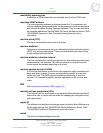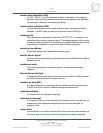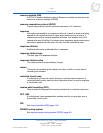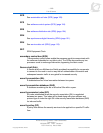
- 113 -
List of terms
Nortel Multiservice Switch 7400/15000/20000
Terminology
NN10600-005 7.2S1 Standard
PCR7.2 and up March 2006
Copyright © 2006, Nortel Nortel Confidential
requested shaping rate (RSR)
One of a set of ATM traffic characterization values used to define traffic
characteristics through the traffic descriptor types.
RSR defines the traffic shaping rate that is requested for a connection. This
parameter is optional. If defined, the requested rate is used as a basis for
determining the actual shaping rate; if not defined, traffic shaping is
determined by the PCR and SCR rates defined for the connection through the
traffic descriptor type.
RSR is Nortel Multiservice Switch system-specific and is not part of the ATM
Forum specification.
The five values used in the traffic descriptor parameters are peak cell rate
(PCR), sustainable cell rate (SCR), maximum burst size (MBS), cell delay
variation tolerance (CDVT), and requested shaping rate (RSR).
rerouting
Re-establishing a logical connection using different Nortel Multiservice Switch
trunks or ATM links than the last connection.
rerouting node
The node that is responsible for establishing an alternate connection segment
(rerouting segment) to a predetermined rendezvous node.
rerouting segment
A connection segment that is used to replace an incumbent connection
segment.
reset
An action taken on an entity (either a shelf or a processor card) that causes
all software on that entity to first reload and then restart. A reset can be
initiated either by an operator or by the system.
resource availability information group
The resource availability information group contains information that the PNNI
network nodes use to assign values of topology state parameters against
nodes, links, and reachable addresses.
resource management (RM) cell
In ATM networking over ABR connections, a cell that carries congestion
information. ABR sources (see
source/destination (page 124)) send RM cells
into the network. ABR destinations then turn these cell around. During the
return trip, ABR nodes deposit congestion information in the RM cells. The
source uses the congestion information to influence bandwidth allocation to
ABR VCs and call admission control.


















